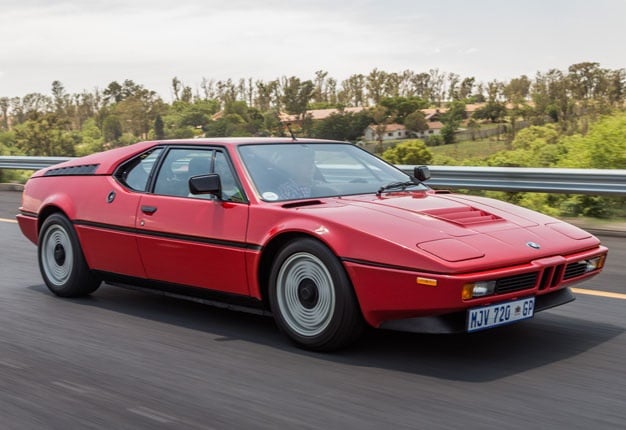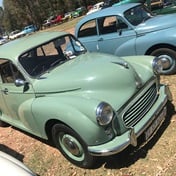
Cape Town - An incredibly rare 1981 BMW M1, one of only 399 road version ever built, was recently (end December 2016) uncovered in an Italian garage where - forlorn and abandoned - it has been collecting dust for the last 34 years.
According to the Munich based Bavarian sports car specialist Mint Classics the M1, still in complete original condition, has been left to perish since 1982. When found it only had 7 392km on the odometer and was still fitted with the supercar's original tyres manufactured in 1980.
Mint Classics indicated it intends to return the bright red M1 to its original condition, and based on the information and pictures available this may not prove too difficult to do. And when done, it could easily fetch up to R8 million from eager collectors…
SA’s only M1 restored
Just a couple of month prior to this priceless barn find BMW South Africa, as part of its activities to celebrate the BMW Group’s centenary, finalised the refurbishment of the one and only M1 in the country, purchased from a customer in the mid-1980s.
The vehicle, originally blue in colour, was repainted in the same red brand positioning colour of the M1 than the example recently found in Italy.
Original BMW materials used
Also completely refitted were the seats, steering wheel, dashboard and carpets at the then seat and upholstery supplier in Rosslyn, using original BMW materials.
The supercar was also mechanically overhauled, with the refurbishment completed by the company’s press vehicle technicians and two apprentices from the BMW Training Centre at Plant Rosslyn.
And after the painstaking renovation was concluded a few had the rare opportunity to acquaint themselves with this iconic sports car – the model that nearly four decades ago, according to Munich, was the originator of the magnificent M-brand (although unofficially the SA-built 530 MLE should be viewed as the first real M-car).
A difficult gestation
Originally conceived as a Porsche challenger the M1 (internally designated the E26) had a problematic gestation period and an even worse birth process. So painful was the experience that for over a decade any mention of it was banned within the BMW household.
It started forty years ago when Jochen Neerpasch, the then general manager of BMW Motorsport, wanted to build a limited-edition “racing car for the road”.
The idea was to, in order to participate in the FIA’s Group 5 racing class, build a batch of 400 cars design by Italdesign’s Giorgetto Giugiaro and powered by a 3-litre V10 engine developed by engine guru Paul Rosche.
The plan was reluctantly accepted, but as BMW’s Munich facilities were unsuitable for such a limited run, production of the car was to be subcontracted to Lamborghini.
Then it all went wrong.
With only four prototype chassis built Lamborghini went into receivership, and while the M1 was received with wild enthusiasm at the 1978 Paris Motor Show, production still wasn’t assured.
Also, the proposed V10 was shelved due to cost, the M1 receiving a modified version of the M49 in-line six-cylinder engine called the M88. And to add insult to injury the FIA changed the Group 5 homologation regulations, requiring 400 cars not only to be built to qualify, but sold too.
To try save the M1 dream Giugiaro recruited Transformazione Italiana Resina to mould the fibreglass bodies, Marchetti to construct the chassis, and Italdesign to bond the bodies and frames before sending it to Baur in Stuttgart for drivetrain fitment.
Finally it went to BMW in Munich for (sometimes extensive) quality control work.
Creative plan
Meanwhile Neerpasch hatched a creative plan to establish the ultimate one-make racing series using M1’s as support act to Formula 1.
The Procar series, with the top five (independent) qualifying F1 drivers in works-prepared turbocharged 340kW beasts vying for victory against a medley of privateers, was a resounding, but short-lived, success.
Lauda won the inaugural series, with Nelson Piquet victorious in 1980 – when the last of the 399 road cars (some sources say 401, the other 56 were Procars) was built – but after main sponsor Goodyear pulled out at the end of the year, the series did not continue.
While the M1 wasn’t as successful on track as some of its successors, it did score some notable class victories, including winning the American IMSA GTO series in 1981, and some noteworthy Le Mans appearances.
A sublime experience
Admiring the M1 up close it’s delightful to see how the Giugiaro lines, inspired by the mid-engine 2002 Turbo show car from 1972 styled by Paul Bracq, after more than three decades are still remarkably contemporary and attractive. It is very different to anything the German marque had produced up until then, adding to its allure, and for its age fit and finish and the uniformity of the panel gaps are outstanding.
The big doors aid ease of ingress into the surprisingly small cabin, and the low-slung leather and material cladded seats have very limited rearward travel. This makes it difficult for bigger occupants to find a comfortable driving position and the (smallish) pedals, offset to the right, require concentration to manipulate smoothly.
Compared to the eye-catching exterior the unassuming cabin is disappointing. As it primarily was designed as a race car, the plain styling of the instrument panel and centre console looks like an afterthought. Anyway, the Jaeger dials rotate to 280km/h and 9 000rpm respectively and the small leather-trimmed three-spoke steering wheel easily falls to hand. Ah, and in case you wondered, there’s no aircon…
It takes some effort to wriggle oneself into the sports car’s restricted confines, but the low-slung seats, suspended inches above the tarmac, are surprisingly comfortable and supportive.
Turn the ignition key and that 3423cc straight-six 24-valve bursts into life spontaneously and growls ominously at low revs, the Kugelfischer mechanical fuel injection balancing the revs around 2 000rpm while the chain-driven dry-sump engine warms up. The clutch is surprisingly light and progressive but the five-speed ZF gearbox with dog-leg first gear takes some getting used to, particularly the shift from first to second, and hurried shifts are not recommended…
On the road
In contrast to most supercars from the same period (think Lamborghini Countach, Ferrari F40, Porsche Carrera Turbo) the M1 is docile in traffic, pottering along serenely and without remonstration, pulling cleanly from as low as 1 000rpm even in fifth gear. From 3 500rpm it really comes on song, accelerating all the way to the red line, accompanied by a most enthralling six-pot wail. It’s addictive, and it required steely self-control to withstand the urge to floor it in every gear…
With the Rosche masterpiece delivering a stout 204kW at 6 500rpm BMW claimed a 0-100km/h time of 5.4 seconds, with 160km/h reached in just 8sec and a top speed of 262km/h for the M1 - spectacular (and very believable) performance for nearly four decades ago. Relative to the do-it-all-for-you artificially enhanced experience in modern supercars it is hard work to pilot the M1 fast and fluently. And therein lays the thrill, as its unassisted steering and Dallara-tuned suspension gives undiluted and untainted feedback.
The double wishbone setup with adjustable Bilstein shocks and anti-roll bars front and rear offers a surprisingly plaint ride quality, even over undulations while a 4.22:1 limited-slip differential with 40 percent locking and bigger 16-inch Michelin tyres (225/50) aft sublimely keeps the rear in check.
’Seventies sports cars were notoriously underbraked, but not so the M1, its vented ATE discs with 11.8" rotors in front and 11.7" ones at the rear responding crisply to any middle-pedal input… Being so in tune with driver input, without relying on any electronic aids makes driving the M1 an engaging and immersive experience… It is driving in its purest, unadulterated form, requiring your full commitment and attention, yet civil and focused – even at three digit speeds. And it’s these traits that made the M1 a sought after classic.
It created a lasting legacy, assuring the future of the hallowed M badge and over a period of nearly forty years spawned many more legendary production road and race cars.
I reluctantly handed back the keys of the M1, still reminiscing on the experience of steering a proper supercar - from a time when driving one was an all-involving, all-consuming act; fun and real.




 Publications
Publications
 Partners
Partners















